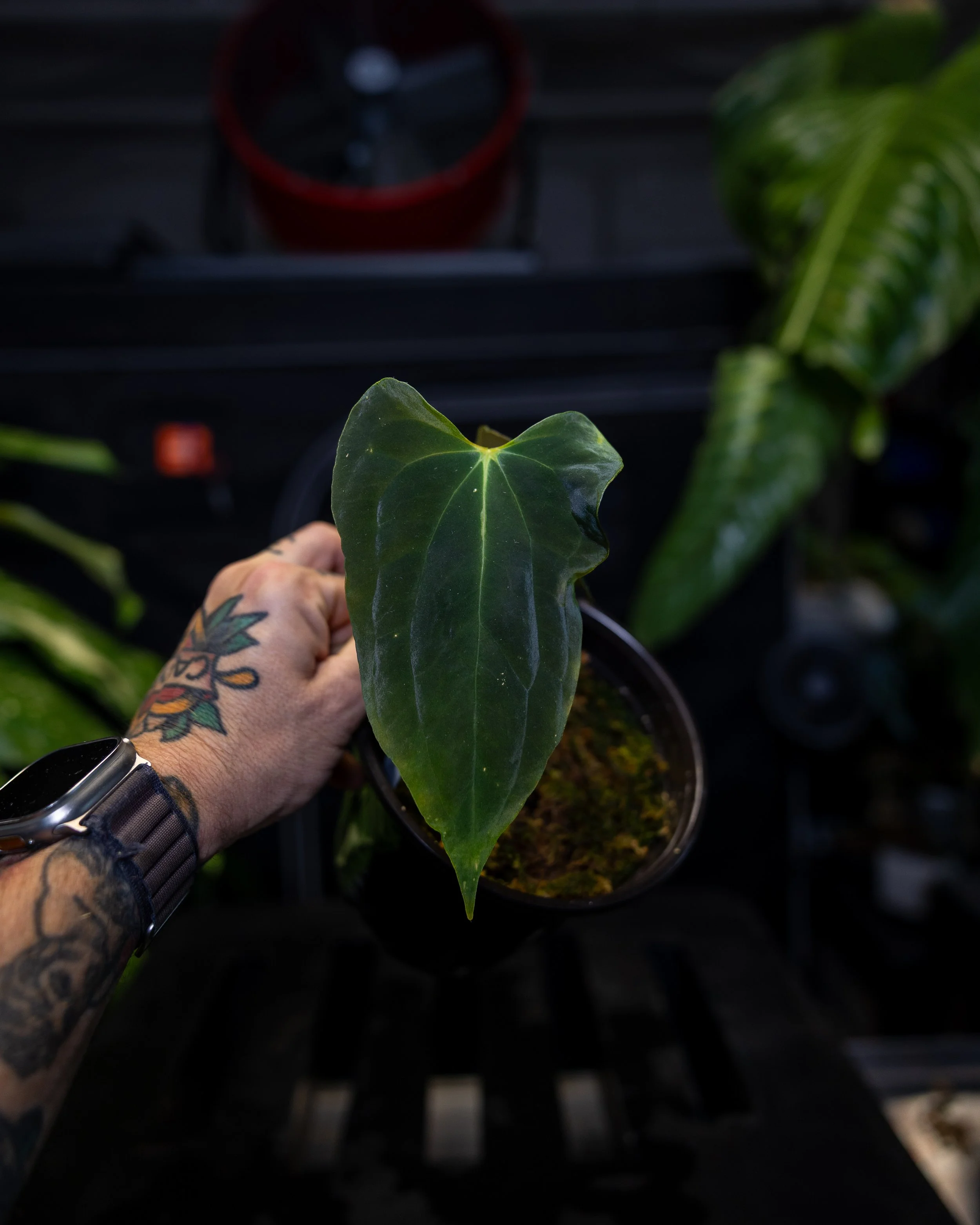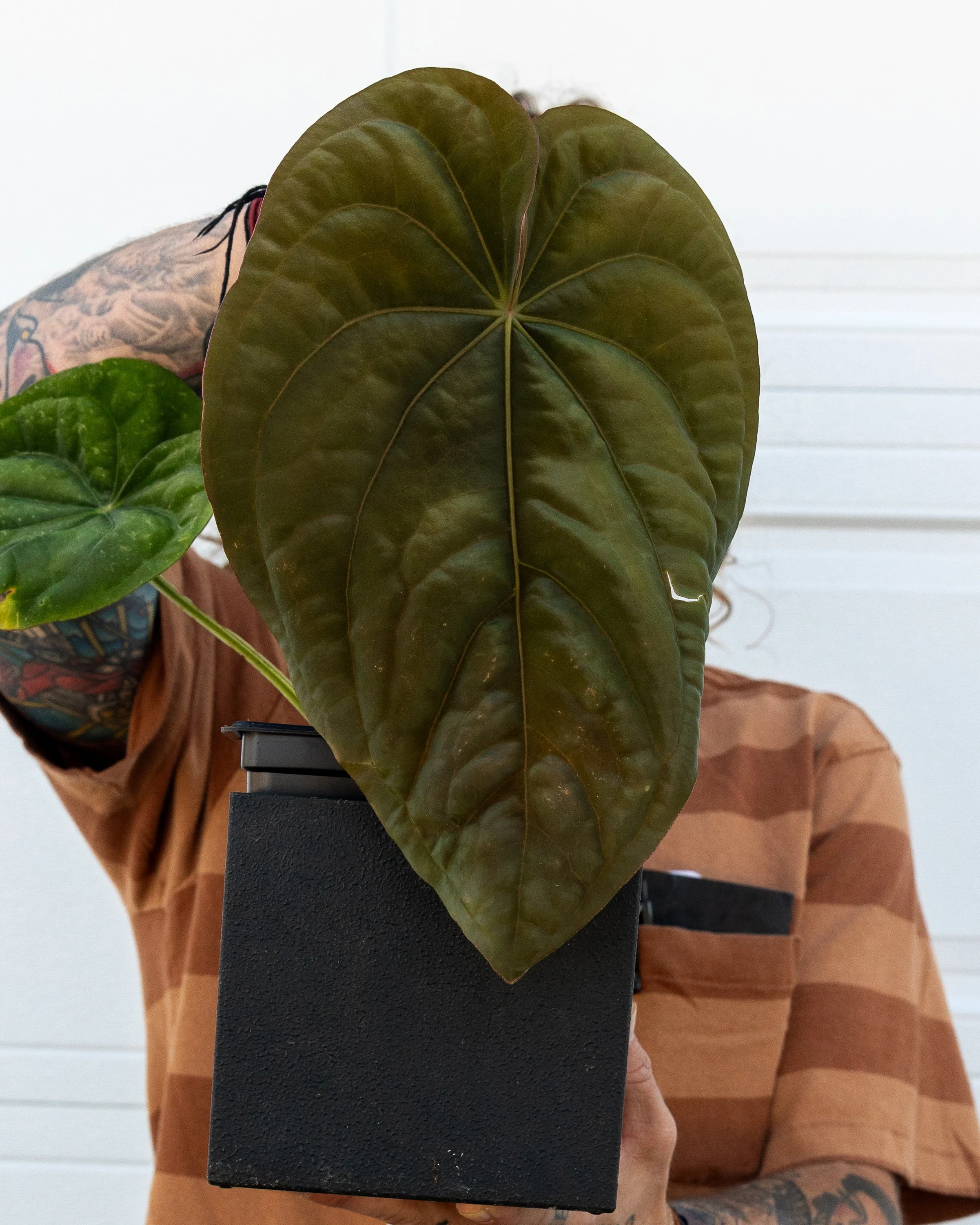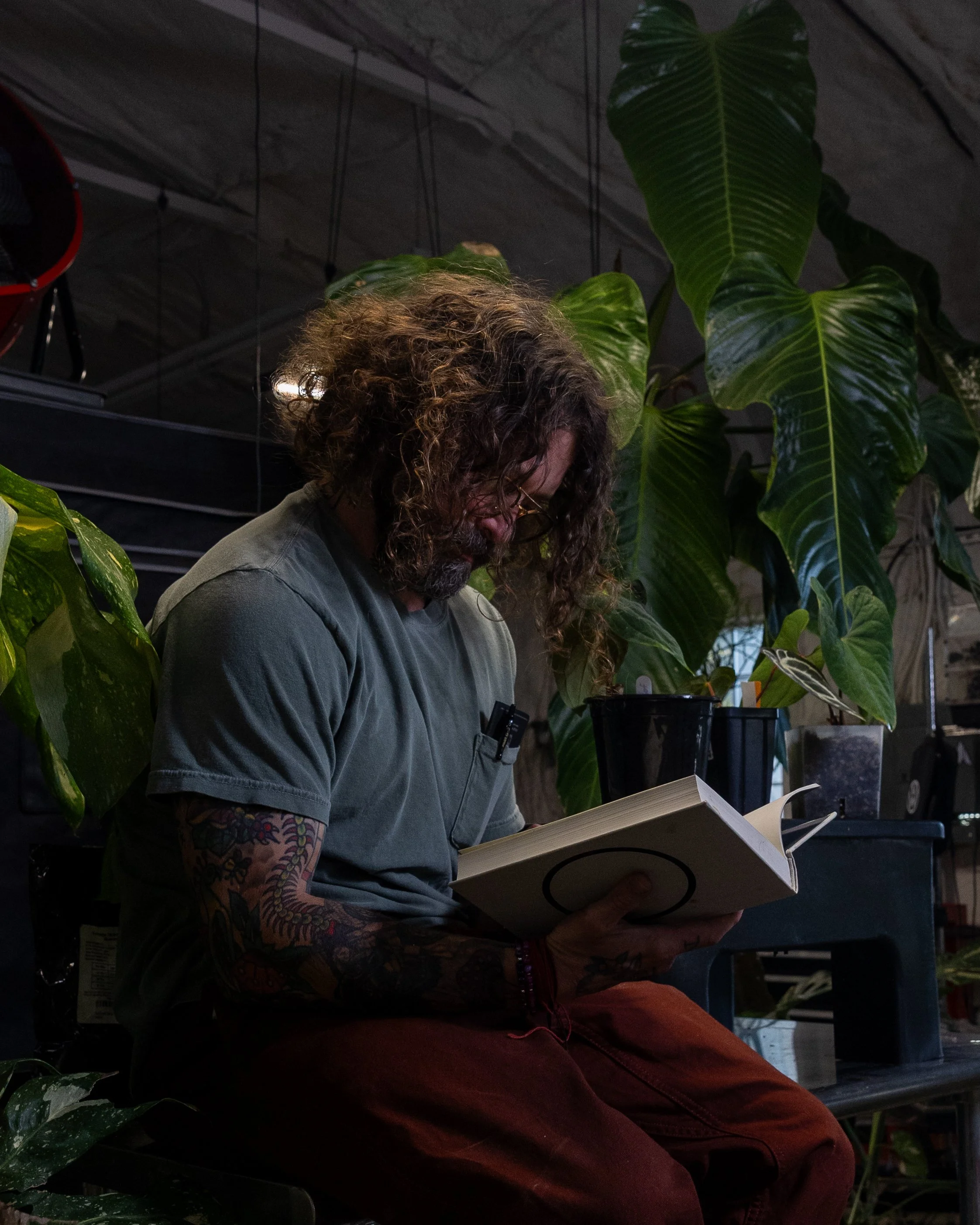Hybrid Hype Man.. 2.0
HYBRID HYPE-MAN 2.0
A Garage Tropics Note on Creation, Provenance, and the Strange Joy of Human-Plant Collaboration
True species are no problem, seed grown Anthurium papillilaminum hit just as hard as wild origin.
Imagine an anthurium hybrid getting the Rick Rubin treatment: the kind of behind-the-scenes champion who quietly turns weird ideas into global hits.
Now route that hype through the old Arecibo dish, blasting signals powerful enough to bounce off planets.
Then throw in DNA polymerase, the enzyme that makes replication possible: speeding, copying, re-building life itself.
That’s the hybrid world:
a producer, a megaphone, and a molecular accelerator all rolled into one…
If you search “anthurium hybrid for sale,” you’ll find a global bazaar: hobbyists in spare bedrooms, commercial nurseries in the Malay Peninsula, growers in Colombia, Australia, Europe; all releasing their own interpretations of the dark-velvet ideal.
And sure, hybridizing anthuriums has been going on since the late 1800s, but I’m not here for the old floral-arrangement era. I’m here for the neo-goth foliage era: plants named Voodoo Child, Ace of Spades, Midnight Velvet. Plants meant for tents, moss bins, and collections where the LEDs run late and the owner checks emerging leaves like omens.
People don’t just want leaves.
They want lore.
Names that feel mythic, geographic, or otherworldly; because collecting is never just botany. It’s story-building.
Why Anthuriums Hybridize So Easily (and What That Says About Them)
Anthuriums are natural free-lovers: promiscuous by design.
Evolution built them that way.
Their flowers are “perfect,” moving through a female stage first (with pollen-receptive droplets and fragrant signals even humans can smell) and then a male stage, producing usable pollen. If the flower isn’t pollinated during the female stage, it simply switches to Plan B: self-pollen.
This gives humans a loophole into the system.
A plant produces the material; a hobbyist with a paintbrush decides its destiny.
It’s a small example of the quiet partnership humans have always had with non-human systems: we read signals, bend patterns, store information for later.
The plant supplies the blueprint; we play archivist, midwife, accomplice.
Tulpenmanie, Orchidelirium, Aroidmania
Charles Mackay missed the best part, the fact that every plant craze echoes the same pattern.
1630s Dutch collectors went bankrupt chasing the next Semper Augustus.
Victorian gentlemen sent explorers into jungles for orchids.
And in 2019–2021, the aroid world watched history rhyme in real time.
Tulips required specialized techniques.
Orchids demanded laboratories and patience.
Anthuriums? They’re “down to clown.”
Two blooms, a tent, a paintbrush, sphagnum — and within one calendar year, you can produce seedlings that never existed before.
Yes, commercial operations are technical and precise.
But the barrier to entry is lower than almost any other ornamental genus.
And that shift — letting everyday collectors become creators — matters.
It democratizes the information cycle.
Wet goddess in silver and black. Seed grown Anthurium carlablackiae produced in the USA by Fontanimal Plant House WSNX from wild origin material from a known Florida plantsman. This is RA14 x RA13 for those initiated to the Aroid Underworld.
What We Owe the Neo-Tropics
Every foliage anthurium in the hobby originates from Latin America.
Full stop.
From Amazonian flood forests to Andean cloud lines, from Chocó’s dripping slopes to Panama’s steamy river corridors — the neo-tropics hold the ancestral library.
Every hybrid, every cultivar, every UBA seedling traces back to that living archive.
And we’d be irresponsible to ignore the reality:
nothing we do as hobbyists will halt deforestation or counteract corrupt governments, mining interests, narco-terror networks, or international exploitation.
Those forces operate on scales far beyond plant collecting.
But we can avoid adding pressure.
We can refuse to participate in extraction.
We can choose ethically sourced plants, U.S.-grown stock, or hybrids created from known, legal material.
This isn’t moral grandstanding — it’s information hygiene.
If we benefit from a region’s natural library, the least we can do is avoid becoming another data point in the history of taking.
Building Value: Data, Honesty, Chain of Custody
A sustainable anthurium-hybrid market only works if value is real.
Not hype, not vibes — actual informational value.
That means:
geographic specifics when available
chain-of-custody transparency
honest labeling
communication between breeders and collectors
If you’re spending serious money on a plant, the seller should be able to tell you where the parents came from. If they get irritated when you ask, that’s your answer.
This isn’t gatekeeping.
It’s literacy.
Knowing your plant’s origin story lets you connect to it the same way you’d connect to a book with a good foreword: context enriches meaning.
Hybrids, Cultivars, Novel Crosses, Selflings
Here’s where definitions matter — but not enough to scare you off.
True hybrids:
Reproducible crosses that can be remade anytime the parent plants bloom together.
Examples like crystal mag (crystallinum × magnificum).
Great for price accessibility, stable traits, and predictable vibes.
Cultivars:
Technically, clones selected for a specific exceptional phenotype.
Think Voodoo Child, Black Magic, Big Trouble.
These aren’t reproduced from seed — they’re divisions, pieces of a single remarkable individual.
Novel hybrids:
Uncharted territory.
Never made before, unpredictable, sometimes incredible.
Like Jay Vannini’s rugulosum hybrids (Quechua Queen, Carib Queen).
These are where creativity hits the frontier — where probability and imagination shake hands.
Complex hybrids:
When accurate data matters most.
Justin Jones’ (forgetii × carlablackiae “Amanda”) × ’Black Velvet Eastern Panama’ ‘Felix’ is a perfect example: clear parentage, clear story, clear value.
F1 example of Anthurium sp. nov. ivaportillae by Jay Vannini- combining wild origin genetics to make seed grown specimens for hobbyists like me.
Selflings / Intraspecies crosses:
Pure species produced domestically — like SHERM (papillilaminum ‘Ft Sherman’ × self) or BVEP ‘Round’ × ‘Felix.’
These keep species accessible without extraction.
All of these categories matter because they shape how collectors understand the information encoded in a plant.
The more accurate the data, the more the plant becomes a story you can trust.
UBAs and NOIDs: Mystery, But Honest Mystery
Unidentified Breeding Anthuriums get a bad rap, but they’re essential.
High-volume hybrids created without definitive parent data still have aesthetic value — as long as the seller is transparent.
If you want dark velvet or strap-leaf structure, there’s probably a UBA that checks the box without breaking your wallet.
Just stay flexible on phenotype.
Unknown parents mean unknown outcomes — which is half the fun.
Hybrid Vigor Is a Gift
One reason hybrid collecting is addictive:
many hybrids grow like they’re trying to prove a point.
Viejo Enigma and Quechua Queen blow past their parents in speed and leaf size in my collection.
It’s the reward loop we all secretly crave:
fast growth, dramatic texture, jungle-goth energy with less diva behavior.
The plant doesn’t just grow — it tells you it wants to be here.
That is its own kind of animism.
The Bigger Picture
The point of all this isn’t just to rank hybrids or flex provenance checks.
It’s to show that value in the hobby is built, not assumed.
Collectors shape the market by choosing:
documented plants
ethical sourcing
breeders who care
transparency over hype
A USA seed grown version of the darkest and most coveted of them all: Anthurium dressleri. Plant and image belong to Arthur Knott. Plant courtesy of Fontanimal Plant House WSNC.
Every hybrid is a tiny collaboration between evolutionary memory and human curiosity.
A negotiation between the ancestral rainforest and the LED tent.
A new informational pattern entering the world.
When you buy one, ask questions.
Not to interrogate — but to connect.
Good Questions to Ask Sellers
“Do you have pictures of both parent plants?”
“Have you sold this cross before? Any photos of mature seedlings?”
“Is there variation in this seed batch?”
“Where did the parent plants originate?”
(You can soften this with humor:
“I’m a plant nerd and love building backstories. Any details help!”)
If they get offended, thank them for their time and move on.
There’s always another hybrid, another story you can trust.
If You Want to Support the Regions These Plants Come From
Donate: http://alianzaandina.org/
HYBRID HYPE-MAN
(You may now imagine Metro Boomin saying it.)
Reading Rick Rubin’s book with a giant seed grown nervatum overhead watching like a glossy green pterodactyl.





